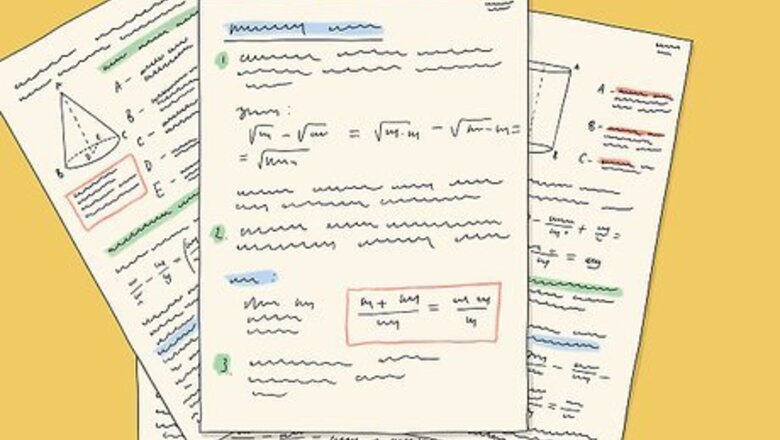
views
Preparing for a Math Exam in One Day
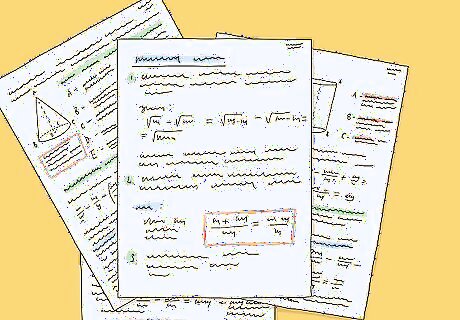
Review your notes for the most important formulas and information. If you have been taking notes in class, you can use them to target what you study over the next 24 hours. Identify any important formulas or other information that your teacher stressed in class. This will likely show up on the test, so read through your notes on it carefully. If you don't have good notes, ask a classmate if they would mind sharing their notes with you. They may be willing to let you read their notes or even make a copy of them to help you study.
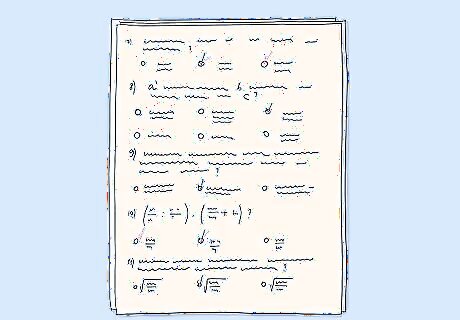
Take a practice test if your teacher provides one. Some math teachers will give their students a practice test that they can use to study. If your teacher provides a practice test, take it and read through it several times and make sure you understand everything on it. Some of the same problems may show up on the actual math test, so making sure you fully understand the test will increase your chances of passing. You can also make your own practice test using problems from class and your book. Another option is to look up relevant practice tests online. Advocate for answer keys with your practice test and homework materials. This way, you can get instant feedback on whether or not you completed the problem correctly.

Create a study sheet with the most important information. Identify all of the most important formulas, concepts, terms, and other information that you think you will need to know to pass your test. Then, write this information down on a note card or sheet of paper. Keep it on you and take it out to read through it whenever you get a chance. For example, you could read over your study sheet while riding the bus, waiting in line, or even right before class.Tip: Some math teachers will allow you to create your own cheat sheet for the test. This may be the size of an index card or 8.5 by 11 in (22 by 28 cm) sheet of paper depending on your teacher's guidelines. Write any information on this sheet you think you will need to know to pass the test.
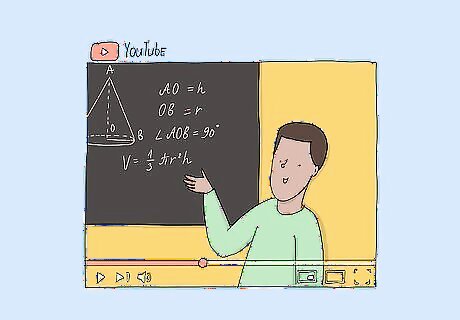
Watch YouTube videos for quick explanations of difficult concepts. If you are still struggling to understand a concept, check to see if there are any YouTube video explanations of them. These may be easier to follow than material in a textbook or your notes. For example, if you are struggling to understand how to add and subtract fractions, find a video that explains it in an engaging, clear way.
Studying for a Math Exam
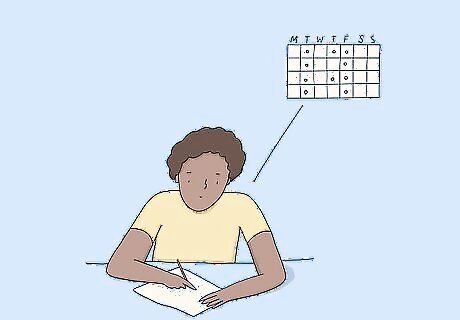
Do the assigned homework for your class. Your math teacher will likely assign homework on a regular basis that is meant to help prepare you for tests. Make sure that you always do the homework, even if it is optional or not worth many points. Doing this extra work will help to prepare you for the tests, which will help you pass the class. Complete extra problems if you are having trouble with a concept. For example, if your teacher assigns all of the even problems at the end of the chapter, do the evens and the odds. Your textbook may have a section in the back where you can check your answers. If it does, use it to see how you are doing. Write out the required formula for each problem as you do the homework. This will make it easier for you to remember it when you take a test.
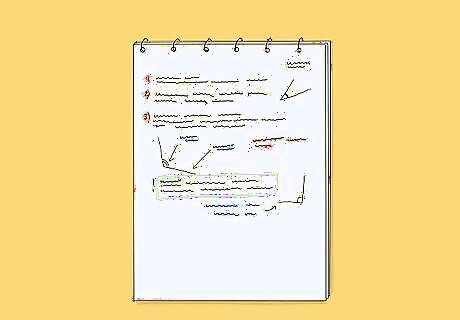
Review your notes and focus on what will be covered on the test. If you take good notes, this will be a valuable resource for helping you pass your exams. Try to read your notes on the same day you took them to reinforce the information that you learned in class that day. For example, you could read through your notes after your class, before you do your homework, or when you study.
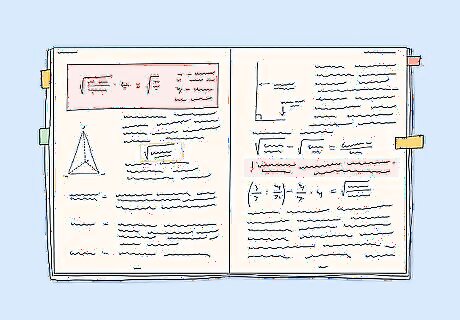
Read the assigned chapters to understand concepts. Although you may not enjoy reading your math textbook, it is a great way to ensure that you understand the concepts and terms your teacher covers in class. Take time to carefully read the chapters your teacher assigns and ask questions if something is unclear. Highlight or underline important passages while you read so that it will be easy for you to come back to them later on. Mark important pages with sticky notes so you can quickly refer to them.

Create flashcards to remember important terms and formulas. Flashcards are index cards with information on both sides. You can use flashcards to help you memorize math formulas, key terms, and concepts. Write the formula, term, or concept on 1 side of the card, and then write an explanation and an example on the other side. For example, if you want to memorize the math formula for a quadratic equation, then you could write the formula on 1 side of the card, and then write an explanation of how to use the formula along with an example on the opposite side.
Ask your teacher or math tutor if you don't understand something. There will be concepts that give you trouble, and when this happens, it's best to ask for help as soon as possible. Talk with your math teacher or a math tutor about any concepts that you don't understand. They can provide more information to help you grasp the concept. If you're in a college math class, visit your professor during office hours to get some extra help.Tip: If you enjoy studying with other people, try joining a math study group. Pass a Math Test Step 5 Version 3.jpg
Improving Your Performance on Test Day
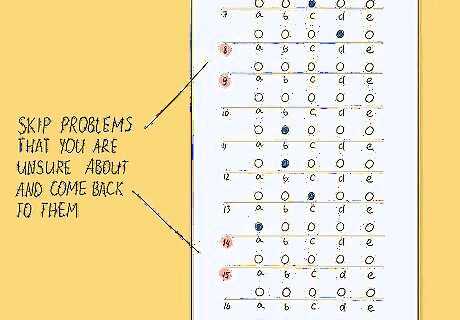
Skip problems that you are unsure about and come back to them. It's best to complete the easiest problems on a test first since these will take you less time. If you encounter a problem that has you stumped, skip it and come back to it after you have tackled all of the easiest problems.Tip: This may mean doing some parts of the test out of order, but don't worry! It's better to jump around than to try to complete the problems in sequence and run out of time.

Read through word problems and extrapolate the numbers. Word problems can be very confusing, especially when they contain lots of extra information that does not contribute to the math of the problem. Take a minute to read through each of the word problems on a test first, and identify the relevant numbers to solving the equation. Then, plug the numbers into a formula that will help you to find a solution. For example, if the problem reads: “Albert has 27 cars that he wants to park on his lawn, and each car requires a 10 by 10 ft (3.0 by 3.0 m) space. Albert's lawn is 100 by 180 ft (30 by 55 m). How many of the cars can he park on his lawn?” The relevant numbers for this problem are the number of cars, the amount of space per car: 10 by 10 ft (3.0 by 3.0 m), and the total size of Albert's lawn: 100 by 180 ft (30 by 55 m).

Show all of your work and include any additional information you can. Even if you get an answer wrong, some teachers will award extra points if you show your work and include extra information that demonstrates your knowledge. Make sure to write out as much detail as you can for each problem, especially if you are unsure about the answer. For example, if you need to complete an equation using a specific formula, write the formula out first. Then, complete the equation using the formula and show any additional calculations you need to do to complete the problem.
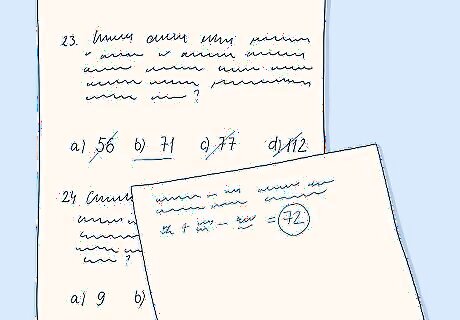
Eliminate any options that you think are wrong. As you go through the test, you may encounter some problems that you are not sure about. To increase your chances of getting points for a question you are unsure about, you can eliminate any responses that you think are wrong. Try to solve the problem, and then eliminate any answers that are clearly wrong. For example,say you complete the problem and get 72 as your answer, but the options available are a) 56, b) 71, c) 77, and d) 112. You could eliminate a and d since they are far off from your answer. Your best option would likely be b since it is the closest to the answer you got.
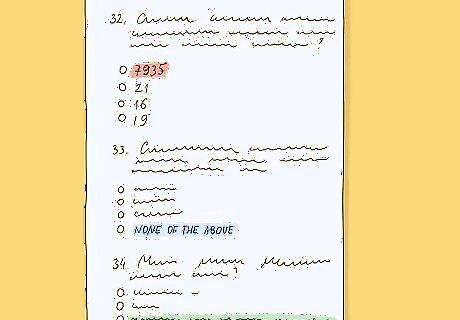
Guess the answer if all else fails. If the problems are multiple choice and you are not sure what the right answer is, then you can try to guess the answer. Go with the option that seems like the right response if you have an idea of what that might be. Some additional ways of guessing the answer include: Avoiding choices that are very different from the other responses. Opting for an “all” or “none” answer if these are options. Going with the longest answer option for a word problem.




















Comments
0 comment